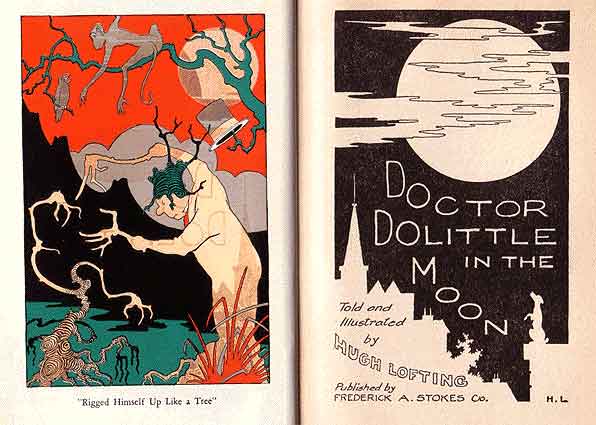Difference between revisions of "December 16, 2004"
| Line 12: | Line 12: | ||
</table> | </table> | ||
<table width="80%" border="0" align="center" cellpadding="8"> | <table width="80%" border="0" align="center" cellpadding="8"> | ||
| − | <tr><td><div align="center" class="main_sm">Image Credit: [mailto:tychocrater@yahoo.com Chuck Wood]</p> | + | <tr><td><div align="center" class="main_sm"><p>Image Credit: [mailto:tychocrater@yahoo.com Chuck Wood]</p> |
</div></td> | </div></td> | ||
</tr> | </tr> | ||
| Line 21: | Line 21: | ||
<p align="left">When I was young - 8 or 9 maybe - I read Hugh Lofting's books about Dr. Dolittle, a wise doctor who had the gift of talking to animals and plants. Dr. Dolittle went on various expeditions, including in this 1928 volume, to the Moon. He and his companions traveled from Earth to Moon by moth (which is no more extraordinary than the travel by demons in Kepler's [[April_7,_2004|<i>Somnium</i>]]), and relied, quite sensibly, on emergency rations of chocolate. The book was not all a childish tale, for facts about the Moon appeared casually throughout the story. There were cup-shaped mountains - extinct volcanoes, explained the Dr. - and walking or bounding was easy because of the lower gravity. Of course, the lunar forests and animals were not found by Apollo astronauts, but probably because the trees were on the far side, which, as the Dr. said, was where the water must be for Earth's astronomers had not seen it on the nearside. I am happy to have recently acquired another copy of <i>Dr. Dolittle in the Moon</i> to reread the simple tale and to wonder how much it influenced me.</p> | <p align="left">When I was young - 8 or 9 maybe - I read Hugh Lofting's books about Dr. Dolittle, a wise doctor who had the gift of talking to animals and plants. Dr. Dolittle went on various expeditions, including in this 1928 volume, to the Moon. He and his companions traveled from Earth to Moon by moth (which is no more extraordinary than the travel by demons in Kepler's [[April_7,_2004|<i>Somnium</i>]]), and relied, quite sensibly, on emergency rations of chocolate. The book was not all a childish tale, for facts about the Moon appeared casually throughout the story. There were cup-shaped mountains - extinct volcanoes, explained the Dr. - and walking or bounding was easy because of the lower gravity. Of course, the lunar forests and animals were not found by Apollo astronauts, but probably because the trees were on the far side, which, as the Dr. said, was where the water must be for Earth's astronomers had not seen it on the nearside. I am happy to have recently acquired another copy of <i>Dr. Dolittle in the Moon</i> to reread the simple tale and to wonder how much it influenced me.</p> | ||
<blockquote> | <blockquote> | ||
| − | <p align="right">— [mailto:tychocrater@yahoo.com Chuck Wood]</blockquote> | + | <p align="right">— [mailto:tychocrater@yahoo.com Chuck Wood]</p></blockquote> |
<p align="left"><b>Related Links:</b><br> | <p align="left"><b>Related Links:</b><br> | ||
[http://lofting.thefreelibrary.com/ Hugh Lofting] | [http://lofting.thefreelibrary.com/ Hugh Lofting] | ||
| + | </p> | ||
<p align="left"><b>Tomorrow's LPOD: </b> Roris Rump</p> | <p align="left"><b>Tomorrow's LPOD: </b> Roris Rump</p> | ||
</tr> | </tr> | ||
Revision as of 20:08, 17 January 2015
A Doctor on the Moon
Image Credit: Chuck Wood |
|
A Doctor on the Moon When I was young - 8 or 9 maybe - I read Hugh Lofting's books about Dr. Dolittle, a wise doctor who had the gift of talking to animals and plants. Dr. Dolittle went on various expeditions, including in this 1928 volume, to the Moon. He and his companions traveled from Earth to Moon by moth (which is no more extraordinary than the travel by demons in Kepler's Somnium), and relied, quite sensibly, on emergency rations of chocolate. The book was not all a childish tale, for facts about the Moon appeared casually throughout the story. There were cup-shaped mountains - extinct volcanoes, explained the Dr. - and walking or bounding was easy because of the lower gravity. Of course, the lunar forests and animals were not found by Apollo astronauts, but probably because the trees were on the far side, which, as the Dr. said, was where the water must be for Earth's astronomers had not seen it on the nearside. I am happy to have recently acquired another copy of Dr. Dolittle in the Moon to reread the simple tale and to wonder how much it influenced me. Related Links: Tomorrow's LPOD: Roris Rump |
|
Author & Editor: Technical Consultant: Contact Translator: A service of: |
COMMENTS?
Register, and click on the Discussion tab at the top of the page.




